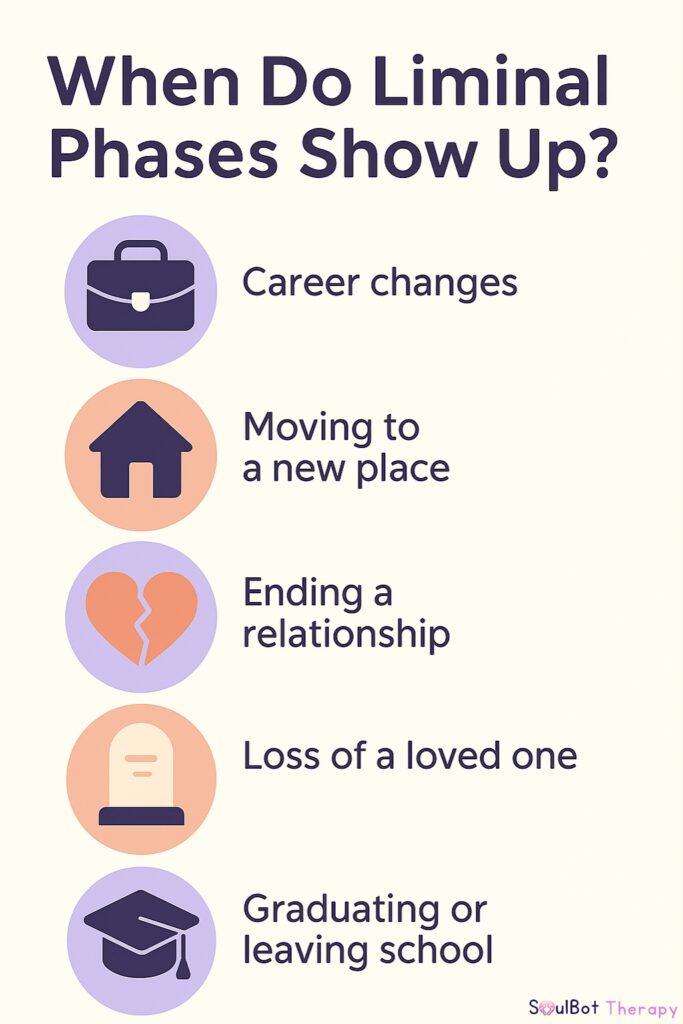You’re Not Broken. You’re Becoming.
Ever feel like you’re floating in the in-between? You’re not who you were, but not yet who you’re becoming. That uncomfortable tension is liminal anxiety.
- It’s not burnout.
- It’s not depression.
- It’s the anxiety of uncertainty of not knowing what’s next while everything familiar fades away.
Whether you’re ending a relationship, changing careers, or questioning your identity, this mental limbo can feel like free fall.
But here’s the truth: liminal anxiety is a signal, not a diagnosis. And with the right tools, including AI mental health support, you can use this strange space for fundamental transformation.
🧠 What Is Liminal Anxiety?
Liminal anxiety is the emotional tension that shows up during life transitions, those messy middle moments where nothing feels solid. The term “liminal” comes from the Latin word limen, meaning “threshold.” In psychology, it describes that “in-between” state during a significant shift.
You’re not stuck. You’re suspended.
Signs You’re Experiencing Liminal Anxiety:
- Feeling lost or unanchored
- Doubting your purpose or identity
- Restlessness without clear direction
- Emotional spikes: joy, sadness, anger, all in a day
- Obsessively questioning “what’s next?”
🔬 What Science Says About This “Emotional Limbo”
According to a 2023 APA research summary, uncertainty can activate the brain’s fear center (amygdala) even more than a known negative outcome. That’s why liminal phases, no matter how hopeful, feel scary.
Psychologists tie liminal anxiety to identity disruption. You’re rewriting who you are, and your mind hasn’t caught up yet. Emotional limbo isn’t weakness; it’s your brain buffering while you reboot your life.
Anthropologist Victor Turner called these moments “rites of passage.” Translation? You’re not broken. You’re becoming someone new.
⚠️ What Triggers Liminal Anxiety?
You might not realize you’re in a transition until anxiety hits like a wave. These moments often trigger it:
- Breakups or betrayal (relationship betrayal triggers major identity shifts)
- Job changes, layoffs, or graduation
- Moving cities or countries
- Gender or identity exploration
- Spiritual or existential crisis
- Chronic illness or loss
- Life stage shifts (midlife, parenthood, retirement)
The event itself doesn’t cause liminal anxiety. It’s caused by the pause between what was and what will be.

😣 How Liminal Anxiety Shows Up
This kind of anxiety isn’t just mental; it’s physical and emotional, too.
Emotional Symptoms
- Unexplained sadness or irritability
- Emotional numbness followed by intense waves
- Feeling like you’re faking your whole life
- “I don’t know who I am anymore,” thought
Physical Symptoms
- Sleep issues despite being exhausted
- Gut problems, headaches, and muscle tension
- Fatigue that rest doesn’t fix
Mental Patterns
- Rumination, overthinking every choice
- Foggy memory or zero focus
- Existential dread (“What’s the point?)
Fact: A 2023 study in Health Psychology Open revealed that people in identity transitions reported higher emotional fatigue but also higher post-transition clarity when supported by mental health tracking tools like journaling and guided prompts.
✅ How to Cope with Liminal Anxiety (Without Faking Positivity)
Liminal anxiety is real, but it’s also manageable. Here’s how to work with it, not against it:
1. Name the Transition
Use the word “liminal.” Labeling it takes away its power. Say: “I’m in a liminal phase.” It reframes panic into progress.
2. Add Micro-Rituals
You may not control the big stuff, but you can control your morning.
- Light a candle. Write one honest sentence. Stretch for 3 minutes.
- Use apps like SoulBot to track moods and get gentle emotional prompts daily.
Micro-rituals rebuild stability.
3. Train Uncertainty Tolerance
We’re wired to hate ambiguity. But you can build the muscle.
- Try mindfulness practices
- Journal what you can control today
- Use SoulBot’s “identity shift” prompt series to sit with uncertainty without spiraling
4. Reauthor Your Story
Your past isn’t your prison. Use narrative therapy techniques:
- Write your “in-between” chapter
- Visualize your future identity without forcing it
- Revisit the love language test on SoulBot to rebuild emotional intimacy with yourself or others
🧰 When AI Mental Health Support Helps
Not everyone’s ready for a therapist. That’s where AI support like SoulBot’s mental health assistant fits in.
SoulBot helps with:
- Daily mood tracking
- Reflective journaling
- Safe LGBTQ+ identity exploration
- Gentle nudges toward clarity without judgment
This isn’t generic chatbot advice. It’s emotionally intelligent AI that grows with you, without toxic positivity.
🧠 Long-Term Tools for Navigating Liminality
You can’t rush transformation, but you can build the skills to endure it.
Develop Emotional Resilience
- Learn how emotions work, not just how to suppress them
- Use self-compassion, not pressure, as a growth tool
Build a Support System
- Confide in people who don’t rush your healing
- Use digital therapy tools alongside (not instead of) real connections
Stay Curious About Who You’re Becoming
- This phase isn’t the end; it’s the reboot.
💬 Final Thought: Liminal Isn’t Lost
This middle space you’re in? It’s not the end. It’s the threshold. Liminal anxiety is your soul stretching, preparing for something unfamiliar but necessary.
Don’t fix yourself. Just witness yourself. The person you’re becoming needs space to arrive.








